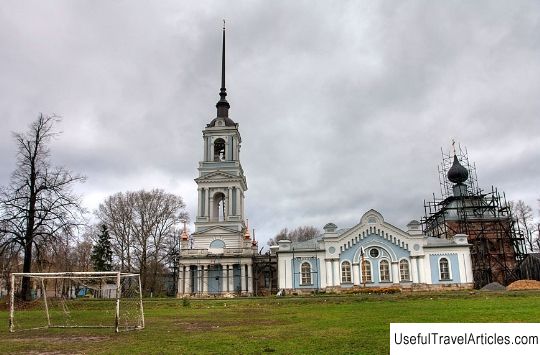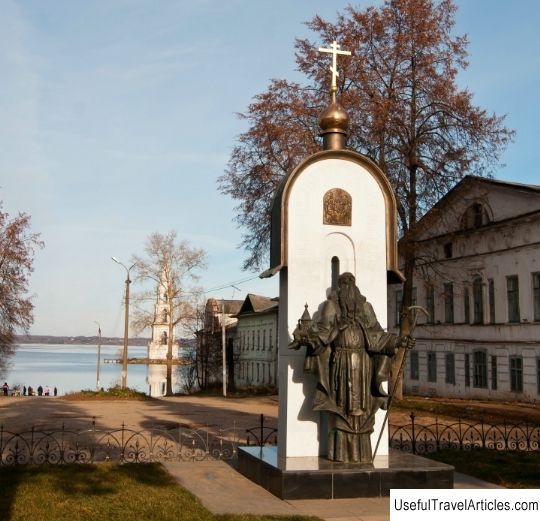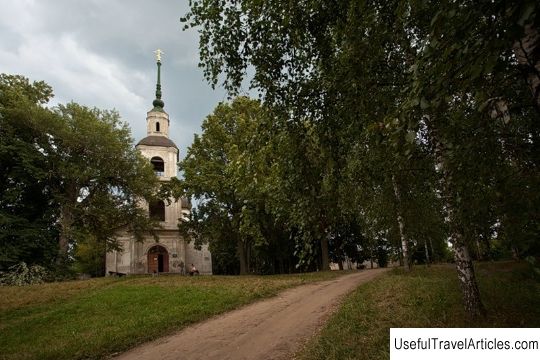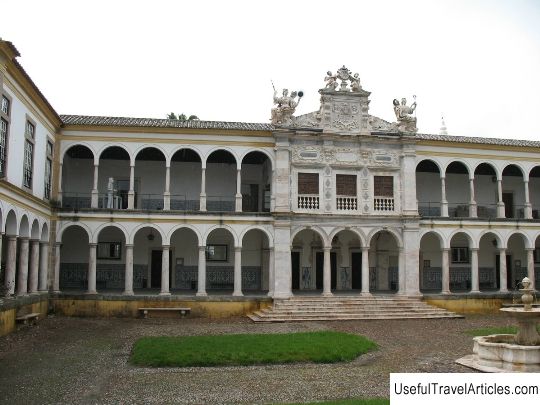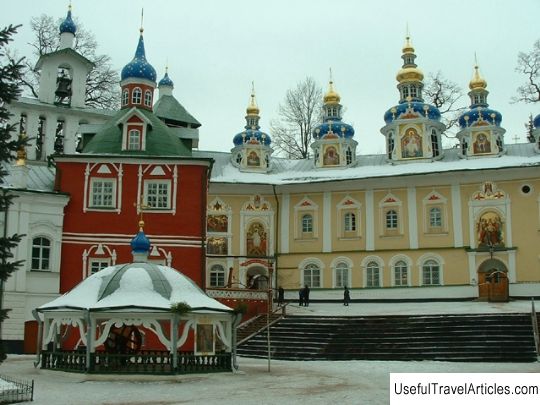Kalyazin bell tower description and photos - Russia - Golden Ring: Kalyazin
Rating: 8,5/10 (809 votes) 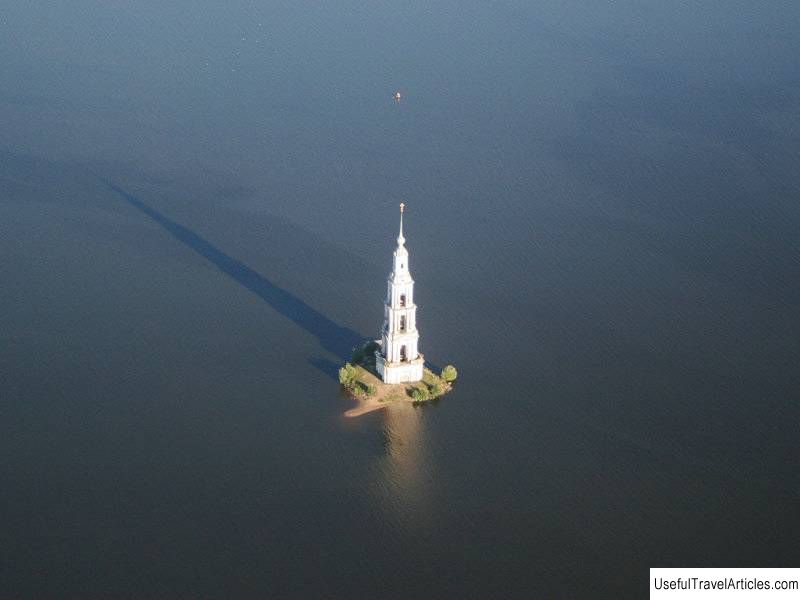
Kalyazin bell tower description and photos - Russia - Golden Ring: Kalyazin. Detailed information about the attraction. Description, photos and a map showing the nearest significant objects. Photo and descriptionThe Kalyazin bell tower is one of the most picturesque and sad symbols of Russia. The historical center of the city of Kalyazin was flooded in the early 1940s with the formation of the Uglich reservoir, only this bell tower was preserved, which still rises above the water surface. Nikolo-Zhabensky and Trinity monasteriesSince the 12th century, the Nikolo-Zhabensky Monastery existed here, which was named after the nearby river Zhabne. Not much is known about this monastery - in fact, almost only the fact that it was here and was destroyed during the Tatar-Mongol invasion - it is the mention of this that allows it to be dated. A legend, recorded already in the 19th century, says that the monastery was rich, and the monks hid treasures somewhere, but no one knows where. The monastery was very small. According to some reports, somewhere in these places there was also a princely fortress, but we do not know its exact location, and we do not know whether it was a monastery. In any case, by the 15th century, Nikolskaya Sloboda already existed around the Nikolsky Monastery - a trading settlement that eventually turned into the city of Kalyazin. This is due to the founding and growth of another, more famous monastery - Trinity. In 1444, on the other bank of the Volga, approximately opposite the Nikolo-Zhabensky monastery, the monk Macarius settled - in the world Mikhail Kozhin. At first he lived as a hermit, then those wishing to live under his leadership began to flock to him. They built themselves a small monastery with a wooden Trinity Church. And this caused the terrible displeasure of the owner of these lands - Ivan Kalyaga. It is believed that it was his nickname that gave the name to the city. Ivan Kalyaga decided to kill the saint - but then a terrible illness happened. His whole family died, and he himself, already almost dying, called Macarius to him and repented before him. Macarius forgave him and cured him, and then Ivan Kalyaga donated the surrounding lands to the monastery. Since then, the monastery has been called Kalyazinsky. According to other versions, the word comes from the Finno-Ugric word "kola", that is, fish - fishing has always been widespread on the Volga and Zhabna. One way or another, a settlement also begins to grow around the Makaryevsky Trinity Monastery. Makariy himself was buried in his wooden Trinity Church. In 1521, his imperishable relics were discovered and he was canonized. When the monastery was closed after the revolution, they ended up in Tver, and now they have returned to Kalyazin again. Now the relics are in the Church of the Ascension, and in the city itself there is a monument to the Monk Makarii. On modern icons, the saint is depicted with the famous flooded bell tower of the Nikolo-Zhabensky Monastery - the only thing left of the old Kalyazin. From his own Trinity Monastery, which was much larger and richer, almost nothing has survived - before the flooding, all of its buildings were blown up. Only a few fragments remained, some of the removed frescoes and some utensils. Now all this is partly in the Moscow Museum of Architecture, partly in the Kalyazin Museum of Local Lore. In the place where the Makaryevsky monastery once stood, with the fall of water in the reservoir, several islets were formed, a brick chapel appeared on one of them in 2000 - only it now reminds of the former monastery. Nikolsky Cathedral The Nikolo-Zhabensky Monastery is in the center of a growing city. In 1694, a new St. Nicholas Cathedral was built here - but the monastery itself is gradually withering away. In 1764, Catherine II carried out a reform in order to increase revenues to the treasury - too many lands belong to monasteries and do not pay taxes, and too many of these monasteries are of just ten people. Very small monasteries are abolished - this is how the Nikolo-Zhabensky monastery ceased to exist in 1764. His cathedral becomes a parish church on the city's market square. If the monastery is weak, the city cathedral, on the contrary, is getting richer. Since 1775, three settlements: Nikolskaya, around the former Nikolsky monastery, Kalyazinskaya, around the Trinity monastery, and the village of Pirogovo - finally merging, form the city of Kalyazin. In 1792, next to St. Nicholas Cathedral, another church was built - the warm church of John the Baptist, and in 1794-1800 a new pompous five-tiered bell tower was erected. It was located almost opposite the Makaryevsky Monastery, in which a high bell tower was also built in the classicist style in the 19th century, so that both bell towers compete with the view and bell ringing. The bell tower was built at the expense of Vasily Fedorovich Ushakov, the owner of the nearby village of Nikitskoye. The Ushakovs' clan was ramified, they owned several estates in the Tver province, several Ushakovs were buried in the Kalyazinsky Trinity Monastery. But about Vasily Fedorovich, unfortunately, we only know that he was a retired colonel and was born in 1739. By the 50s of the 19th century, Nikitsky was already owned by his grandchildren. In the 19th century, Kalyazin grew and flourished. The production of lace is widespread here - the quality is not too high, but they are inexpensive and there are many of them. Gymnasiums, a city garden, and new churches are under construction. From 1842 to 1887, the priest of Nikolsky (or, as it was called by this time - Nikolaevsky) cathedral is Fr. John Belyustin. He was one of the most famous and most uncomfortable, edgy, ecclesiastical writers of his time. He wrote about the problems of the rural clergy, not hesitating to raise unpleasant questions: about how that the rural clergy, for the most part, are powerless and uneducated, they are forced to engage not so much in nourishing the parishioners, but in search of food, they are oppressed by bishops who are looking only for their income. For his writings for two years (1880-1881) he was banned. During his time in 1885, new bells were cast - funds for them were allocated by the neighboring Trinity monastery. The largest of them weighed five hundred and one poods, and there were twelve of them on the bell tower then. Uglich reservoir In the 1940s, two large hydroelectric complexes, Rybinsk and Uglich, were being built on the Volga under the leadership of Volgostroi. Two huge reservoirs with hydroelectric power plants were created, and part of the historical lands of the Uglich principality fell under the flooding. The Rybinsk reservoir flooded the Mologa, and the Uglich reservoir flooded most of Kalyazin, two thirds. The Trinity Makariev Monastery and the entire historical center of the city with the Nikolsky Church were completely blown up and flooded. Both churches, summer and winter, Nikolskaya and Predtechenskaya, were also blown up before the flooding. Only the bell tower has survived. The bell tower was retained not for nostalgic reasons, but for functional reasons - it worked as a lighthouse and was designated in Soviet documents. The fact is that the river makes a turn in this place, and the ships in any case needed some kind of landmark. It was decided to leave the bell tower as such a reference point. The decision to build the reservoir was made in 1935, and by 1947 the planned territories were completely covered with water. In total, more than a hundred settlements and thirty churches were flooded. The water level in the reservoir has changed and continues to change, fluctuations can be up to seven meters. In the 40-50s, the lower tiers of the bell tower were completely under water. But in the 1980s, the building was reinforced. Then an artificial island was poured around, on which moorings were arranged. In fact, half of the first tier of the bell tower is now flooded. Not so long ago, the water level in the reservoir dropped again due to extreme heat, the foundations were exposed - and it became clear that the bell tower was in emergency condition. The foundation and its strengthening structures are eroded by the current from the river. In 2015, an open petition from the Kalyazin administration was posted on the Internet with a request to include the bell tower in the state restoration program and allocate funds for this. The petition did not receive a large number of signatures, but funds were allocated. Now the bell tower is consecrated again. On May 22, 2007, the first service was held there. Served as her abbot of the Trinity-Sergius Lavra, Ignatius. New bells were cast in the Moscow workshop of Ilya Drozdikhin. By tradition, the annual Volga procession ends at the Kalyazin bell tower. It starts from the sources of the Volga near Lake Seliger, in the village. The Volgoverkhovye, where the Olginsky women's monastery is located, passes through Ostashkov, Staritsa, Tver, Kashin, Dubna - and ends here, on a small island of the Uglich reservoir. Although that there is practically nothing left of the historical center of the city - the residents of Kalyazin remember it and try to preserve their historical traditions. Interesting factsLocal legend says that one bell from the bell tower remained under water: collapsed, breaking through the ceilings, into the basement when they tried to remove it. Sometimes he calls, foreshadowing some kind of trouble - for example, he called in the summer of 1941. Alexander Sergeevich Pushkin was in love with one of the Ushakovs, Ekaterina Nikolaevna, and even came to Nikitskoye. In memory of this, a bust of the poet was erected in Nikitsky, but only a park remained from the estate itself. Now, next to the bell tower, there is a sandy mini-beach where you can swim          We also recommend reading Irakleia island description and photos - Greece: Naxos Island Topic: Kalyazin bell tower description and photos - Russia - Golden Ring: Kalyazin. |
